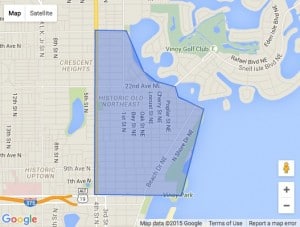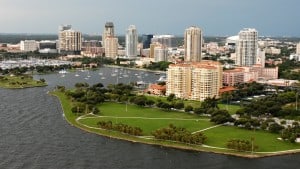The unique character and charm of one of St. Petersburg’s first neighborhoods makes Historic Old Northeast one of the most desirable custom home neighborhoods in the city.
Boasting waterfront parks, brick streets with granite curbs, concrete and hexagon block sidewalks, and picket fences under a dense mature canopy of large oaks, jacarandas, pines, palms, maples and magnolias, “Old Northeast” as it is known, offers a unique blend of New England style and tropical sensibilities.
For boating enthusiasts, you’ll find Coffee Pot Bayou features privately owned docks, with plentiful fishing and sailing in protected waters known for the manatees that feed in its shallow waters.
Located adjacent to downtown St. Petersburg, Old Northeast provides a unique, quiet residential neighborhood experience and easy access to the city’s thriving cultural, entertainment and dining scene. Known for its tight-knit community, the Historic Old Northeast neighborhood association fosters residents getting to know each other through activities such as picnics, porch parties, parades and other activities.
Why is it the Neighborhood Known as Historic Old Northeast?
 Historic Old Northeast, founded in 1911 by C. Perry Snell and J.C. Hamlett was the first established residential subdivision in St. Petersburg. The neighborhood was designated to the National register of Historic Places as a Historic District in 2003. Covering some 425 acres, the neighborhood features 3,220 contributing structures making it one of the two largest National Register districts in the State.
Historic Old Northeast, founded in 1911 by C. Perry Snell and J.C. Hamlett was the first established residential subdivision in St. Petersburg. The neighborhood was designated to the National register of Historic Places as a Historic District in 2003. Covering some 425 acres, the neighborhood features 3,220 contributing structures making it one of the two largest National Register districts in the State.
The Historic Old Northeast neighborhood is defined by 5th Avenue North to 30th street North and by 4th Street North to the west and Tampa Bay all along the eastern border.
Neighborhood Architecture
The Historic Old Northeast neighborhood architecture is a rich mix of Mediterranean, Colonial, Bungalow, Craftsman and Prairie Style homes. Along the bay and the bayou are grand mansions many of which were built in the 1920’s. Most homes were developed in a traditional pattern featuring porches and stoops the address the street, while garages are accessed through an alley network.
Within Historic Old Northeast, there are actually four distinct sub districts:
5th to 9th Avenues:
The oldest area in Old Northeast, this area features older, simpler architectures, Vernacular, Craftsman, and Colonial design with the sidewalks and homes pulled close to the mostly narrow streets. In this section there is a higher concentration of apartment buildings and garage apartments than in the other section of Old Northeast.
9th to 22nd Avenues:
North of 9th Avenue, streets are slightly wider, with homes set further from the street. Moving north and east toward the water, homes are larger and more elaborate while apartment buildings and garage apartments diminish.
22nd to 30th Avenues:
One of the new areas in Historic Old Northeast, much of this area of the neighborhood was built in the 1950’s. Here you will find that most homes were developed with porches facing the street and garages facing the alleyways in the rear.
Granada Terrace:
This section of the neighborhood is unique to Historic Old Northeast. Unlike the highly regulated, street grid and alley pattern used throughout the neighborhood the other sections of the area, Granada Terrace features boulevard style streets that gently curve with larger yards and homes set further back from the street. Created in 1924 by C. Perry Snell, Granada Terrace was designated a Local Historic District in 1988. It features a significant concentration of Mediterranean Revival homes sited on large, tropically landscaped lots.
Why You’ll Love the Waterfront Park System
 The waterfront area of Historic Old Northeast is lined with a greenbelt of parks, including the smaller Flora Wylie Park, expansive North Shore Park and Vinoy Park creating an unparalleled quality of life.
The waterfront area of Historic Old Northeast is lined with a greenbelt of parks, including the smaller Flora Wylie Park, expansive North Shore Park and Vinoy Park creating an unparalleled quality of life.
Overlooking Tampa Bay, Vinoy Park is beautifully manicured and rich with biking walking and jogging trails beloved by locals. Vinoy Park is also where you can catch live concerts and enjoy annual events like Ribfest, and Mainsail Art Festival.
North Shore Park covers much of the eastern boundary of Historic Old Northeast and provides the neighborhood large greenbelt of open spaces, as well as a public pool, tennis courts, a baseball field, a playground for kids, a well equipped dog park and a beautiful white sand public beach perfect for watching dolphin at sunset.
Coffeepot Bayou is home to a cornucopia of marine wildlife including the unique opportunity to watch manatee in the wild. Historic Old Northeast is also home to Sunken Gardens, four acres of botanical gardens with over 500 species of topical foliage amid pools and waterfalls. Established in 1903, it is open to the public for a fee and also host tours, educational programs and special events.
Culture, Shopping, Dining and Things to Do
You’ll find most everything you can want or need nearby Historic Old Northeast. The Great Explorations Children’s Museum is here, as are live performances at eh Palladium Theater at St. Petersburg College, and the historic Renaissance Vinoy Resort and Golf Club. Charming boutique shops line 4th street north, national chain markets like Trader Joe’s and the Fresh Market, and locally owned markets are right in Old Northeast and a farmers market can be found nearby on the waterfront. Along 4th Street North you can find dining options from health food to fast food pizza, bakeries and a neighborhood favorite, Old Northeast Tavern.
Downtown St. Petersburg’s thriving culture, restaurant and nightlife is close by as is Tampa Bay Ray’s baseball and other stadium events.
Interested in learning more about the Historic Old Northeast neighborhood such as school locator information? Ready to talk about building a home in Historic Old Northeast? Use the handy buttons below to learn more or schedule a consultation.
[vc_row][vc_column width=’1/2′][button size=” style=” text=’School Locator’ icon=” icon_color=” link=’https://sap.pinellas.k12.fl.us/PubInfony/’ target=’_self’ color=” hover_color=” border_color=” hover_border_color=” background_color=” hover_background_color=” font_style=” font_weight=” text_align=” margin=”][/vc_column][vc_column width=’1/2′][button size=” style=” text=’Free Consultation’ icon=” icon_color=” link=’http://www.devonshirecustomhomes.com/custom-home-consultation/’ target=’_self’ color=” hover_color=” border_color=” hover_border_color=” background_color=” hover_background_color=” font_style=” font_weight=” text_align=” margin=”][/vc_column][/vc_row]
